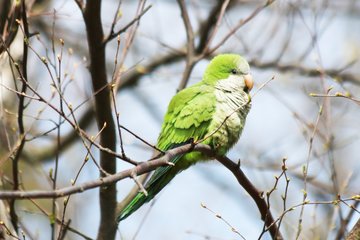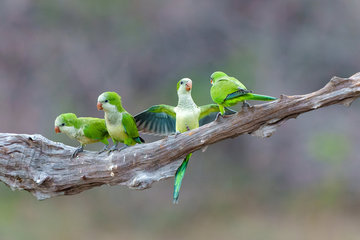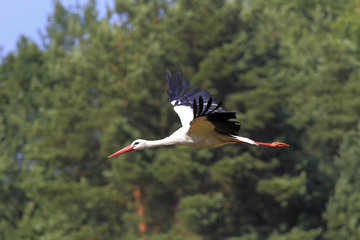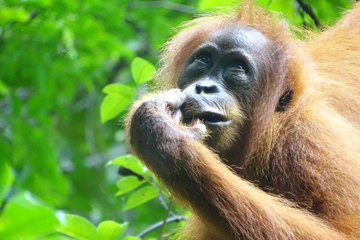Monarch butterflies with a heavy load
Scientists have succeeded for the first time in fitting monarch butterflies with a radio transmitter and in tracking them from an aircraft over a long distance on their flight northwards during the butterflies’ annual migration from their winter residence in Mexico
Martin Wikelski, biologist at the Max Planck Institute for Ornithology in Radolfzell and professor at the University of Konstanz, has, on a number of occasions, used transmitters to observe various animal species, such as birds, tortoises, dragonflies and bats, on their migratory paths. However, the migration of monarch butterflies, which cover thousands of kilometres every year on their journey between the Great Lakes in Canada and Mexico, has never before been studied using this technology. A team from National Geographic accompanied the scientists to document the tracking process for their film "The Science of Migration", which is planned for release in 2010.

Lawrence, a small town in Kansas, May 20, 2009: A group of scientists and a camera team stand side by side on the local airfield. Their concentration is palpable: a small six-legged visitor is expertly held between three fingers and carefully fitted with a small package with tweezers and adhesive. A minute radio transmitter on its abdomen, which weighs half as much as the animal itself, is to accompany the monarch butterfly on the next leg of its journey after the stopover. The scientists, Chip Taylor, director of the organisation Monarch Watch, which is based at Kansas University, and Professor Martin Wikelski, Professor for Ornithology at the University of Konstanz and Director at the Max Planck Institute for Ornithology in Radolfzell, Germany, hope to succeed, for the first time, in getting the butterflies, which have been fitted with a transmitter, to fly and in following them in a small aircraft.
The fluttery visitors are first fed a suitable amount of food to give them enough strength to carry the transmitters. After one butterfly had been released, Wikelski and Taylor followed its signals. "Just as we expected, it flew in a north-northeast direction," said Taylor after the flight, "And it covered a distance of 18 kilometres." The monarch butterfly was then located, first from the aircraft and then from the car, relieved of its extra load. The researchers are hoping for less windy conditions over the next few days to be able to release a larger number of tracked specimens. The collected data will then be entered into the "Movebank", a database of global animal movements initiated by Martin Wikelski, which can be consulted, for example, by national environmental protection agencies and by schools.
The monarch butterfly is the best known of the migratory butterfly species. Every March, millions of individuals fly in large swarms from the mountains of Mexico in the direction of north. By April, they have reached the Rio Grande on the American border, where the females lay the first of their 400 eggs. The caterpillars live off poisonous spurges, which make them unfit for consumption by birds, their natural predators. The conspicuous colour of their wings acts as a warning sign for other animals. By early May, the butterflies have arrived in Texas where this generation’s hazardous and exhausting journey ends with death. The journey, however, is continued by the next generation. This second generation then reaches the latitude of the city of Washington. The grandchildren of the Mexican overwinterers hatch and lay their eggs in Pennsylvania, then in Canada at the Great Lakes. The imagines, the adult animals of this generation, achieve an incredible feat: With the help of strong upwinds, they cross Lake Erie and then negotiate the 3,600 kilometres southwards to reach Mexico again in late autumn.
In the past, it has not been possible to observe an individual butterfly in detail on its migratory journey. Thanks to the successful work of the biologists, however, this is no longer the case. "Now we can compare the migrations of whales, birds, bats and insects, and describe trends that will enable us to predict migratory phenomena, such as the migratory locust."
Despite his extensive experience in observing migrating animal species with the help of small transmitters, Martin Wikelski wanted to first test, on a small scale, whether the adhesive mixture would fix the metallic transmitter to the belly of the butterfly securely, as well as whether the butterfly would be able to fly with this considerable load and whether the signal can be received with directional antennae - hardly a suitable task to be carried out in a laboratory.
The butterfly house on Mainau Island, a well-known tourist attraction on Lake Constance, provided the best possible conditions for the tests. The unique flower and plant paradise was opened to the public by Count Lennart Bernadotte who wanted to provide access to an oasis of harmony and natural beauty. In keeping with this philosophy, a butterfly house was established there in 1996. Visitors can view over 50 species of magnificently coloured butterflies in the tropical landscape of the butterfly house. The surrounding garden complex also provides a place for egg deposition and feeding for native butterfly species.
Here, the Mainau gardeners collected the monarch butterfly pupae for the test run. As soon as they hatched, Wikelski caught one rather dazed butterfly in the cold morning air. A spot of adhesive was carefully applied to its abdomen, the transmitter fitted on top, the drying process completed and the butterfly placed on a Lantana camara flower to recover and gather its strength. Exhausted by the procedure, the monarch did not initially attempt to lift off into the air. However, it eventually teetered off unsteadily, gradually becoming more confident as it became used to the unaccustomed extra weight. The National Geographic team filmed this exciting sequence on location.
Those lucky enough to have observed the flight of the millions of painted lady butterflies this past May, which arrive in Germany every spring from North Africa and the Mediterranean, cannot have failed to have been fascinated by the contrast between these delicate creatures and their ability to overcome enormous distances and altitudes. The migratory paths of these and other butterfly species that manage to cross the Alps every year can finally also be researched in detail.












